Abstract
The dangers associated with the consumption of large amounts of methylmercury in fish are well recognized, and there is some evidence to suggest that methylmercury may be the cause of subtle neurological impairments when ingested at even low to moderate levels, particularly the prenatal and early childhood periods. This concern has prompted a continuing assessment of the risk of methylmercury toxicity among fish consumers in the United States as well as other countries. The toxicokinetics of methylmercury in humans are reviewed and used to estimate body burdens associated with toxic effects. To determine seafood consumption patterns among the continental U.S. population the Food and Drug Administration (FDA) has analyzed data from a diary study commissioned by the Tuna Research Foundation. Mercury residue levels in domestic fish sampled by the FDA were used to determine the level of exposure to methylmercury. Until evidence is presented that substantially lowers the known body burden of methylmercury which causes toxicity, calculations indicate that the current 1.0 ppm regulatory level provides adequate protection for the average fish consumer, for young children, and for a significant number of consumers exceeding the acceptable daily intake. However, additional studies are being carried out in a continuing process to ensure that safe levels of prenatal exposure to mercury residues in fish are maintained.
Full text
PDF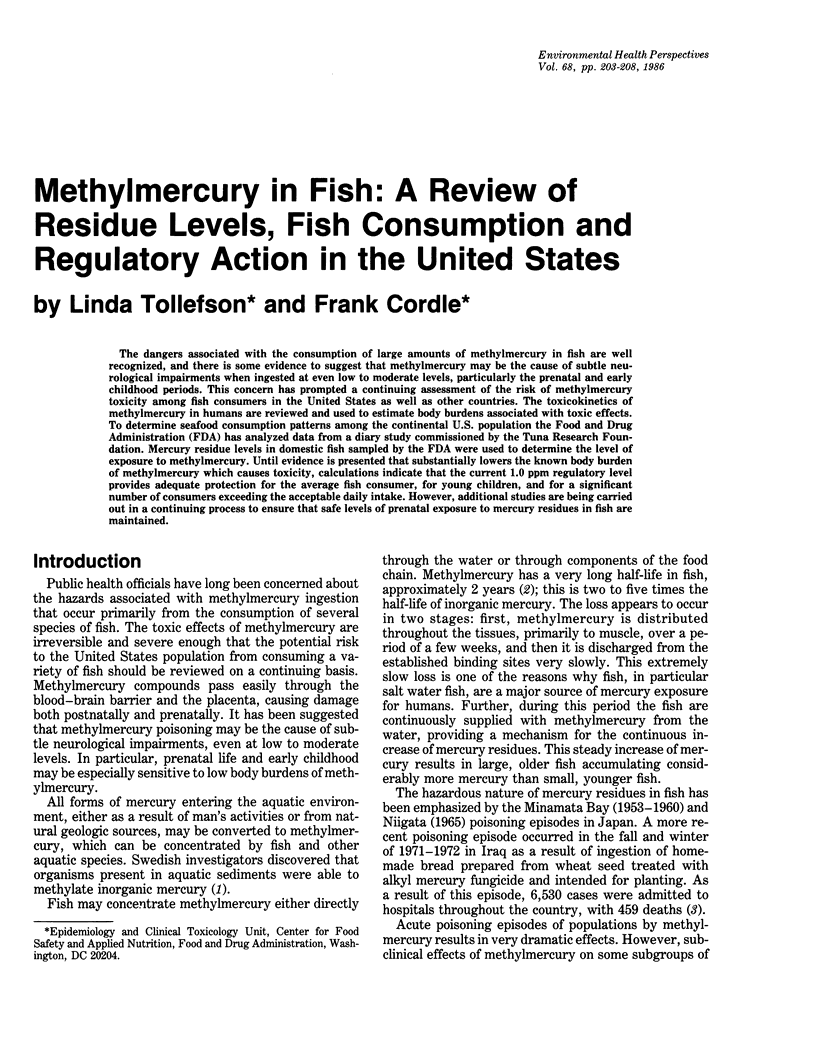
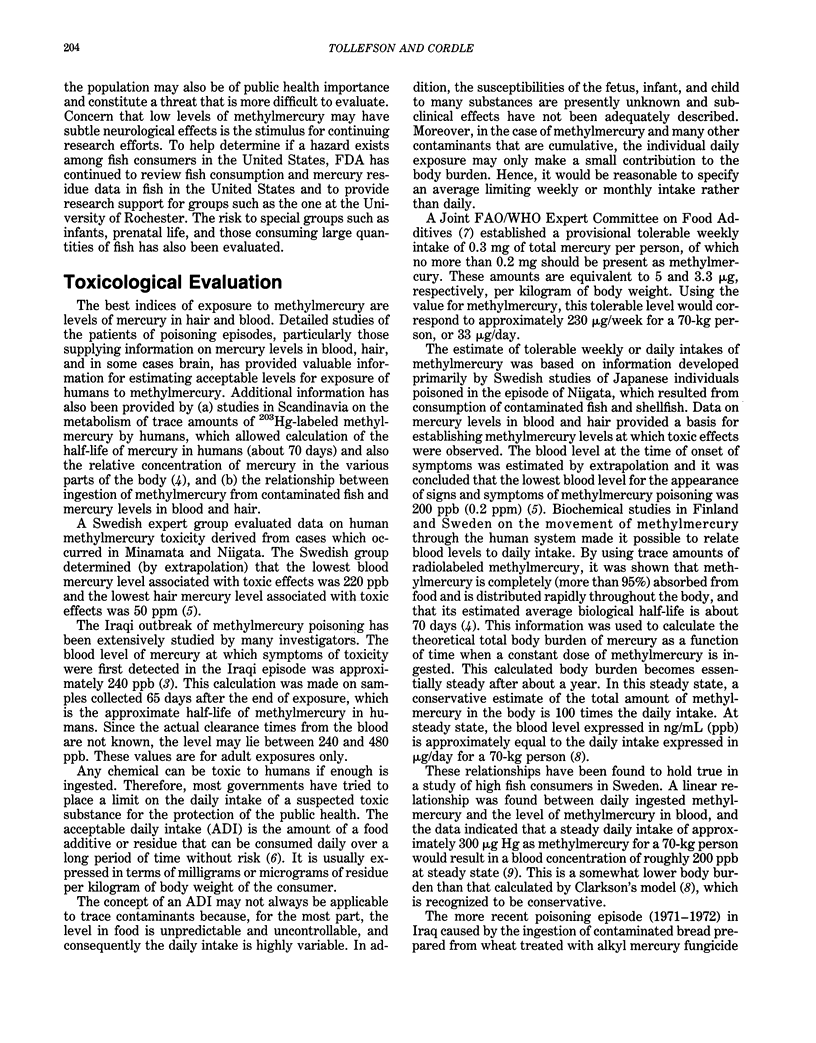
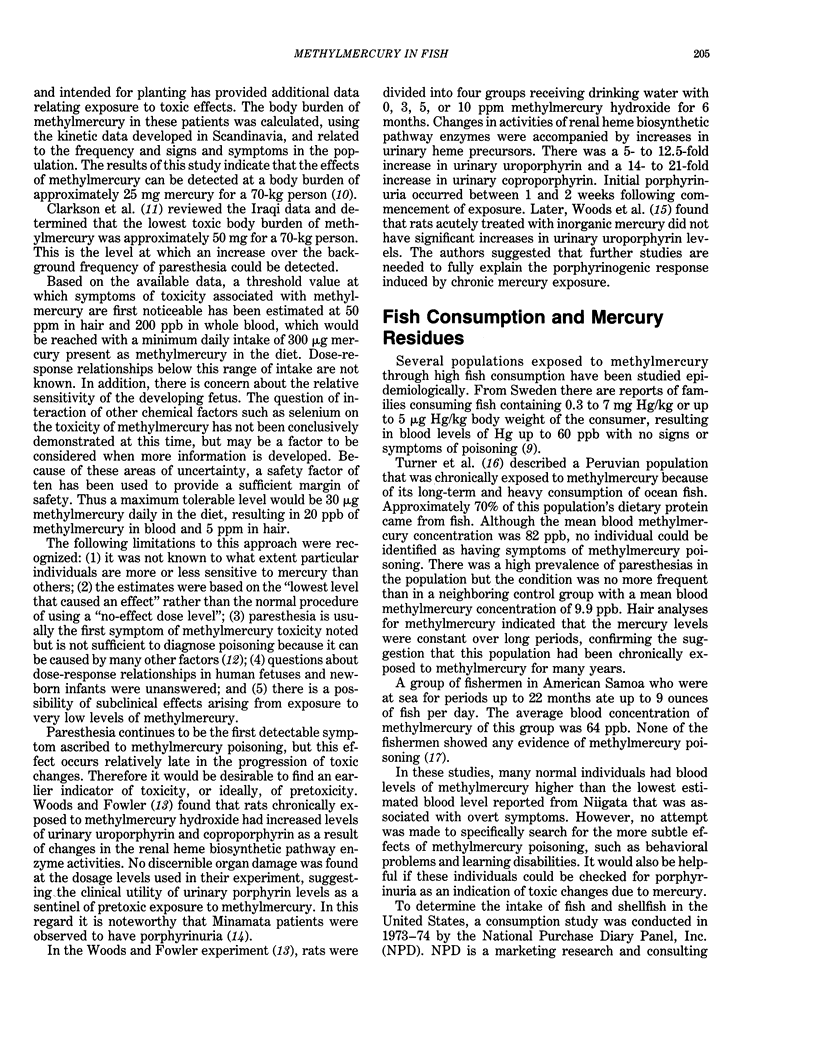
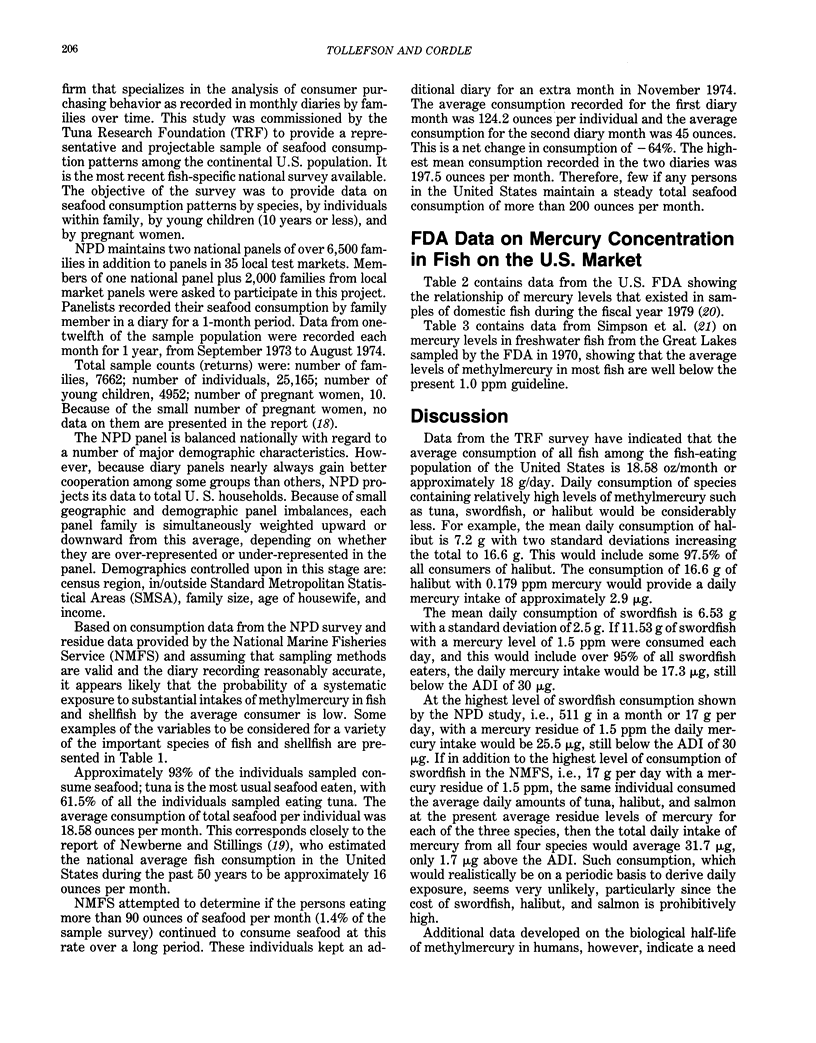
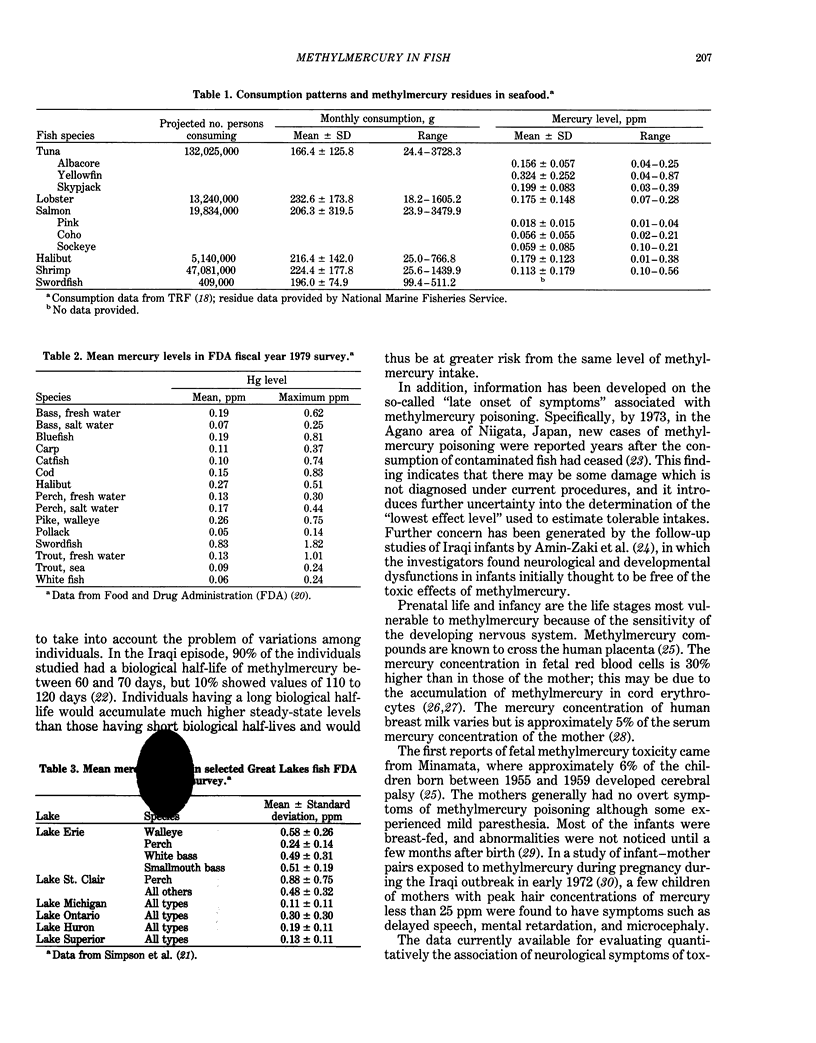
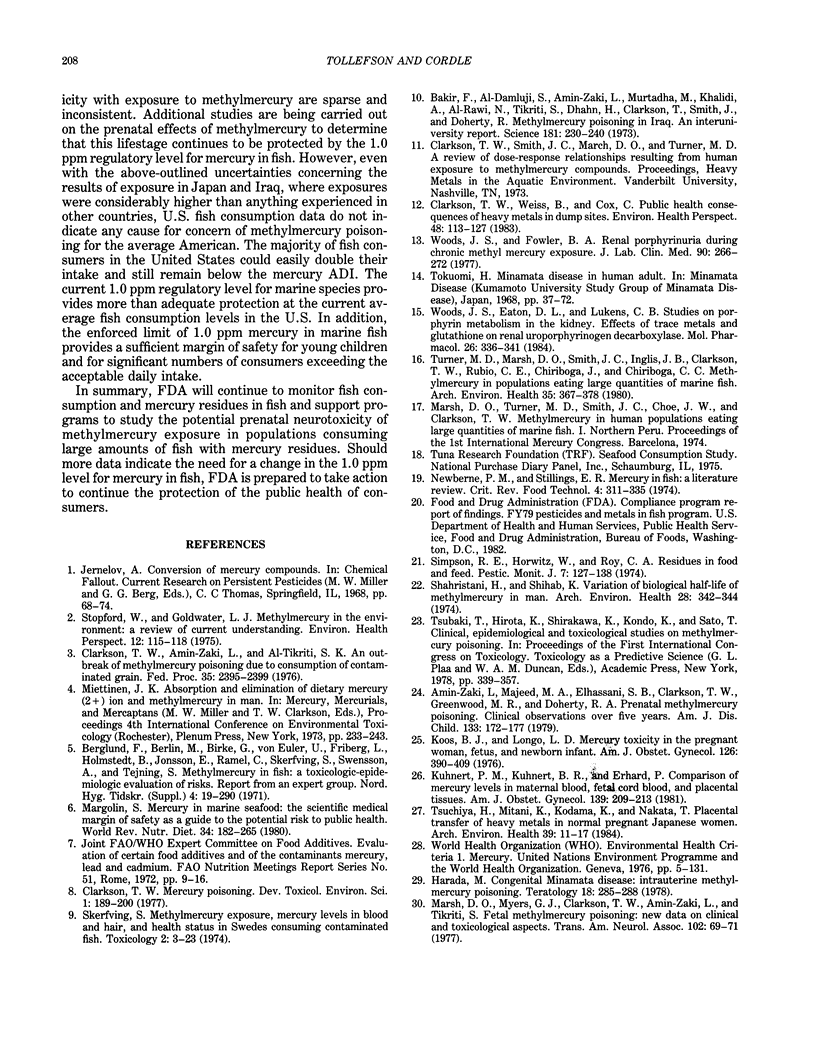
Selected References
These references are in PubMed. This may not be the complete list of references from this article.
- Amin-Zaki L., Majeed M. A., Elhassani S. B., Clarkson T. W., Greenwood M. R., Doherty R. A. Prenatal methylmercury poisoning. Clinical observations over five years. Am J Dis Child. 1979 Feb;133(2):172–177. [PubMed] [Google Scholar]
- Bakir F., Damluji S. F., Amin-Zaki L., Murtadha M., Khalidi A., al-Rawi N. Y., Tikriti S., Dahahir H. I., Clarkson T. W., Smith J. C. Methylmercury poisoning in Iraq. Science. 1973 Jul 20;181(4096):230–241. doi: 10.1126/science.181.4096.230. [DOI] [PubMed] [Google Scholar]
- Clarkson T. W., Amin-Zaki L., Al-Tikriti S. K. An outbreak of methylmercury poisoning due to consumption of contaminated grain. Fed Proc. 1976 Oct;35(12):2395–2399. [PubMed] [Google Scholar]
- Clarkson T. W., Weiss B., Cox C. Public health consequences of heavy metals in dump sites. Environ Health Perspect. 1983 Feb;48:113–127. doi: 10.1289/ehp.8348113. [DOI] [PMC free article] [PubMed] [Google Scholar]
- Harada M. Congenital Minamata disease: intrauterine methylmercury poisoning. Teratology. 1978 Oct;18(2):285–288. doi: 10.1002/tera.1420180216. [DOI] [PubMed] [Google Scholar]
- Koos B. J., Longo L. D. Mercury toxicity in the pregnant woman, fetus, and newborn infant. A review. Am J Obstet Gynecol. 1976 Oct 1;126(3):390–409. doi: 10.1016/0002-9378(76)90557-3. [DOI] [PubMed] [Google Scholar]
- Kuhnert P. M., Kuhnert B. R., Erhard P. Comparison of mercury levels in maternal blood, fetal cord blood, and placental tissues. Am J Obstet Gynecol. 1981 Jan 15;139(2):209–213. doi: 10.1016/0002-9378(81)90448-8. [DOI] [PubMed] [Google Scholar]
- Margolin S. Mercury in marine seafood: the scientific medical margin of safety as a guide to the potential risk to public health. World Rev Nutr Diet. 1980;34:182–265. doi: 10.1159/000403312. [DOI] [PubMed] [Google Scholar]
- Marsh D. O., Myers G. J., Clarkson T. W., Amin-Zaki L., Tikriti S. Fetal methylmercury poisoning: new data on clinical and toxicological aspects. Trans Am Neurol Assoc. 1977;102:69–71. [PubMed] [Google Scholar]
- Skerfving S. Methylmercury exposure, mercury levels in blood and hair, and health status in Swedes consuming contaminated fish. Toxicology. 1974 Mar;2(1):3–23. doi: 10.1016/0300-483x(74)90038-9. [DOI] [PubMed] [Google Scholar]
- Stopford W., Goldwater L. J. Methylmercury in the environment: a review of current understanding. Environ Health Perspect. 1975 Dec;12:115–118. doi: 10.1289/ehp.7512115. [DOI] [PMC free article] [PubMed] [Google Scholar]
- Tsuchiya H., Mitani K., Kodama K., Nakata T. Placental transfer of heavy metals in normal pregnant Japanese women. Arch Environ Health. 1984 Jan-Feb;39(1):11–17. doi: 10.1080/00039896.1984.10545827. [DOI] [PubMed] [Google Scholar]
- Turner M. D., Marsh D. O., Smith J. C., Inglis J. B., Clarkson T. W., Rubio C. E., Chiriboga J., Chiriboga C. C. Methylmercury in populations eating large quantities of marine fish. Arch Environ Health. 1980 Nov-Dec;35(6):367–378. doi: 10.1080/00039896.1980.10667521. [DOI] [PubMed] [Google Scholar]
- Woods J. S., Eaton D. L., Lukens C. B. Studies on porphyrin metabolism in the kidney. Effects of trace metals and glutathione on renal uroporphyrinogen decarboxylase. Mol Pharmacol. 1984 Sep;26(2):336–341. [PubMed] [Google Scholar]
- Woods J. S., Fowler B. A. Renal porphyrinuria during chronic methyl mercury exposure. J Lab Clin Med. 1977 Aug;90(2):266–272. [PubMed] [Google Scholar]
- al-Shahristani H., Shihab K. M. Variation of biological half-life of methylmercury in man. Arch Environ Health. 1974 Jun;28(6):342–344. doi: 10.1080/00039896.1974.10666505. [DOI] [PubMed] [Google Scholar]


